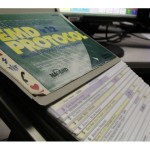Pre-Arrival Instructions: Invasive Call-taking
by: JP Sredzinski, Communications Supervisor
Often times when a person dials 9-1-1 for a medical emergency, there is a fairly straightforward problem such as chest pain, minor trauma, difficulty breathing or a fall. Although these events can be major life changers for those who experience them and their families, due to training and experience, they are handled in a very routine way in the 911 Communications Center. The call taker will ask the pertinent questions, process the call in the computer, and send help on its way.
Then there are the times when Emergency Medical Dispatchers have to get more invasive. Based on the emergency occurring, they will have to get more active in providing care earlier and directly through the caller. This means having the caller become the first person to provide care based on instructions given over the phone. Emergency Medical Dispatchers are provided hours of training in how to deliver these instructions over the phone. These instructions are internationally used and based on current medical best practices. In Connecticut, their use is mandated. There are a number of instances where this becomes necessary and although overly simplified for the purposes of this article, here are some examples:
Choking
If someone calls reporting a choking victim, the call taker is trained to immediately assess the patient over the phone and begin to provide instructions – this is because maintaining a clear airway is critical to a patient’s survival. The call taker will tell the caller to get the phone right next to the patient, put their arms around the waist, make a fist and in one quick motion, jerk hard up into the stomach. Many will recognize this as a modified version of the “Heimlich Maneuver” which is trained in any first aid classes regularly. The objective is to dislodge the obstruction enough to allow for air to move into the lungs before helps arrives on scene and a more in depth assessment can be made.
Maternity and Pregnancy
Often times, a maternity call takes hours to develop and babies rarely get delivered by emergency personnel, never mind over the phone. However, on the rare occasion a baby is ready to enter the world early or without delay, the call taker must be prepared to help the caller deliver the child. This is a very complex and long series of instructions, with more than 40 directions that can be given at any time. The general rule of the call taker is to assist the caller in receiving the child in a safe, sanitary way without pulling, pushing or obstructing the child’s progress. Also, making sure the baby has a clear airway after it leaves the womb is a critical aspect of delivery. The caller may be asked to collect a blanket, clean and dry clothes as well as a string or shoelace for the delivery. It is often said that delivering a child over the phone can be the most rewarding experiences a call taker every gets to have.
Bleeding Control
This can be as simple as it sounds for a minor laceration: get a clean, dry cloth and hold pressure over the wound. Although it can be as complex as looking for body parts after an amputation and securing them for the first responders while maintaining bleeding control at the same time.
Sinking Vehicle
Although not very common, there have been instances when drivers have found their way into large bodies of water and then call 9-1-1 for help. These events are extremely time critical as vehicles can fill with water in less than a minute. Call takers are trained to provide directions on how to escape the vehicle and keep the caller calm when submerged. Sometimes, windows need to be broken and water can be very dark. Staying calm and keeping breathing under control is critical to survival in these events. Following the dispatchers instructions in these cases is critical.
Cardiac Arrest
Unfortunately the all too common pre-arrival instructions given by call takers are for family members that are found to be in cardiac arrest. These are critical situations and because depending on a number of factors, survivability can be favorable. If downtime is minimal, if a defibrillator is available (and used), and if the caller is compliant and accurate with the instructions provided to them, the chances first responders arrive to a viable patient are greater. That being said, the call taker will first instruct the caller to get close to the patient and assess their breathing and responsiveness very closely. Then, depending on the circumstances, callers will be instructed to give chest compressions and numerous breaths by blowing into the mouth of the patient. This is done after the airway is determined to be clear and the patient free of any scene safety issues. CPR instructions continue until help can arrive and take over the care of the patient. The key is to get compressions going within 20 seconds so listening carefully and staying calm is crucial.
Conclusion
When the circumstances require them, emergency call takers must direct callers with specific and scripted instructions in order to provide care to a patient before help even gets on scene. This is why dispatchers are often referred to as the “first, first responders” because through callers, they are actually there providing care before fire and ambulance personnel get on scene. When calling 9-1-1, always be sure to carefully listen to the directions provided to you because the instructions that are provided can easily be the difference between life and death.
To learn more about the Stratford Public Safety Communications Center: Dispatch



